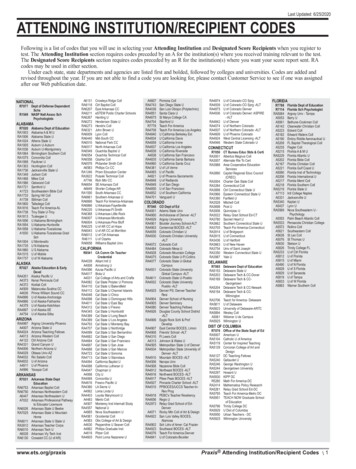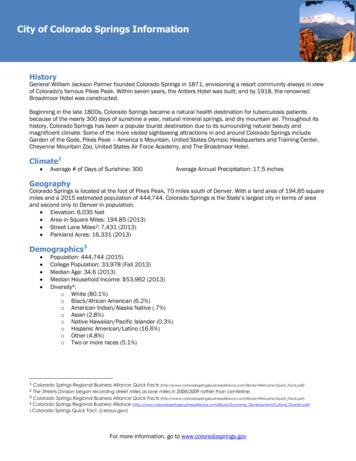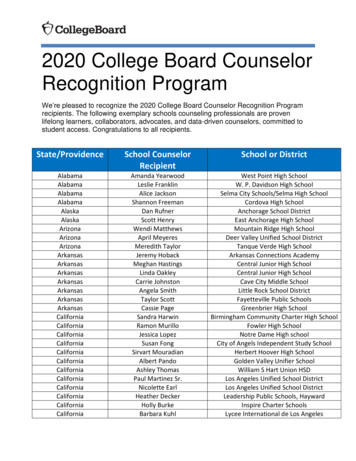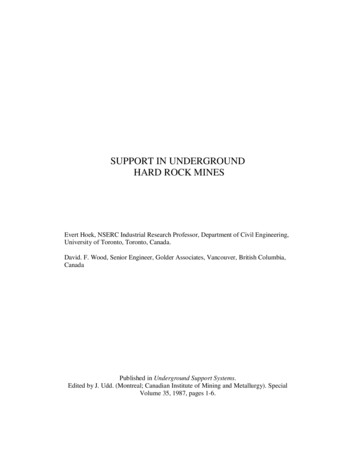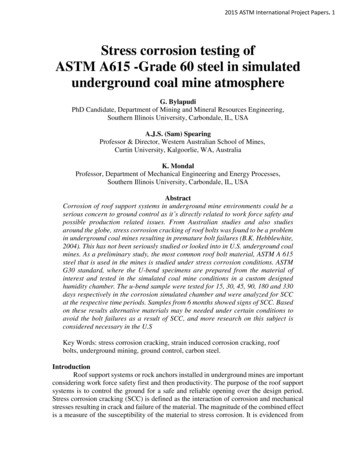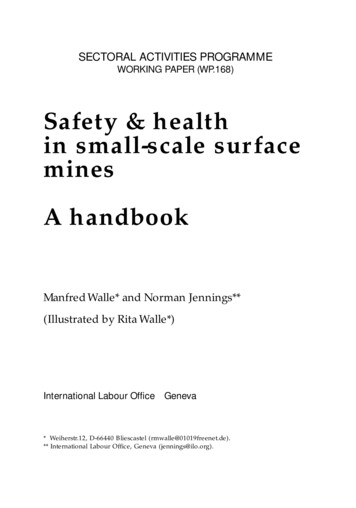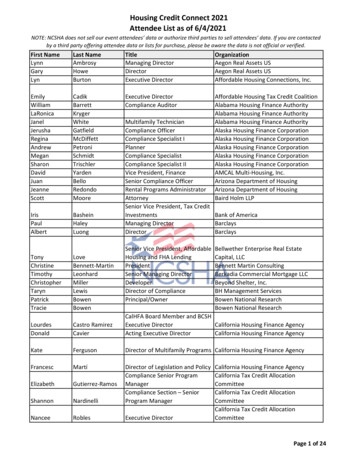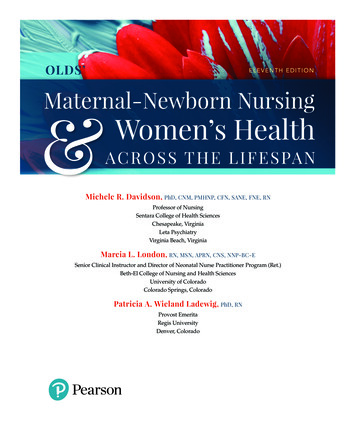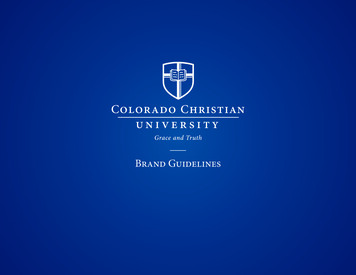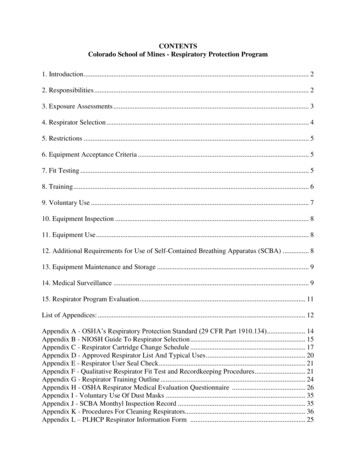
Transcription
CONTENTSColorado School of Mines - Respiratory Protection Program1. Introduction . 22. Responsibilities . 23. Exposure Assessments . 34. Respirator Selection . 45. Restrictions . 56. Equipment Acceptance Criteria . 57. Fit Testing . 58. Training . 69. Voluntary Use . 710. Equipment Inspection . 811. Equipment Use . 812. Additional Requirements for Use of Self-Contained Breathing Apparatus (SCBA) . 813. Equipment Maintenance and Storage . 914. Medical Surveillance . 915. Respirator Program Evaluation . 11List of Appendices: . 12Appendix A - OSHA’s Respiratory Protection Standard (29 CFR Part 1910.134) . 14Appendix B - NIOSH Guide To Respirator Selection . 15Appendix C - Respirator Cartridge Change Schedule . 17Appendix D - Approved Respirator List And Typical Uses . 20Appendix E - Respirator User Seal Check . 21Appendix F - Qualitative Respirator Fit Test and Recordkeeping Procedures . 21Appendix G - Respirator Training Outline . 24Appendix H - OSHA Respirator Medical Evaluation Questionnaire . 26Appendix I - Voluntary Use Of Dust Masks . 35Appendix J - SCBA Monthyl Inspection Record . 35Appendix K - Procedures For Cleaning Respirators. 36Appendix L – PLHCP Respirator Information Form . 25
Colorado School of Mines Respiratory Protection Program1. IntroductionThis document establishes the Colorado School of Mines (CSM) written compliance program forrespiratory protection, as required by the Occupational Safety and Health Administration(OSHA) under Title 29 Code of Federal Regulations Part 1910.134. Appendix A of thisRespiratory Protection Program contains a link to the Standard).This Respiratory Protection Program addresses the use of respiratory protection as a method toprotect CSM employees and students from exposures to airborne biological, chemical, andphysical agents to safe levels below OSHA permissible exposure limits, as well as from oxygendeficient atmospheres (i.e. 19.5% O2) and immediately dangerous to life and health (IDLH)conditions.Whenever feasible, engineering controls and administrative work practice controls will beemployed to maintain worker exposures below exposure limits and at a safe level. Respiratoryprotection shall only be required if these controls are not feasible or are not able to adequatelyreduce exposures to airborne contaminants.The Environmental Health and Safety Department (EHS) shall administer all aspects of thisRespiratory Protection Program.2. ResponsibilitiesVarious CSM departments and employees have responsibilities under this program, including:a. Environmental Health & Safety Department Preparing, reviewing, and periodically revising this program;Providing and/or overseeing respirator fit-testing and training;Making information and training materials available to potentially affected employees;Monitoring and evaluating the need for respiratory protection in the workplace;Providing guidance to supervisors and employees in the selection of approved respirators;Maintaining records of exposure assessments, training, and respirator fit testing;Developing and implementing a medical surveillance program for respirator users;Ensuring that affected employees participate in medical surveillance program;Provide notifications to respirator users to schedule exams in accordance with the CSMMedical Surveillance Program;Reviewing medical surveillance records;Maintaining medical surveillance records;Supplying approved respirators to affected employees free-of-charge; andRequiring affected employees to wear respirators.Page 2 of 12
b. Supervisors Providing new employees with informal on-the-job training about potential respiratoryhazards, personal protective equipment requirements, and the elements of this Program;Notifying CSM EHS about workplace conditions and potentially affected employees whoare covered by this Program;Notifying potentially affected employees of the Medical Surveillance Programrequirements; andEnsuring that affected employees receive respirator training and fit-testing prior toworking with the respirator, and annually thereafter.c. Affected Employees Observing the procedures and requirements outlined in this Program;Attending initial respirator training and annual training and fit testing thereafter;Scheduling and participating in medical surveillance program;Conducting positive and negative pressure check before each use;Inspecting respirators before and after each use;Cleaning, disinfecting and storing respirator for future use.Wearing approved respirators as required; andNotifying supervisors and EHS of changes in the workplace that could change exposures.d. Vice President of Finance and Administration Providing financial resources to the EHS Department to adequately administer this planfor the CSM campus; andAdministering disciplinary action for affected employees who willfully disregard therequirements of this plan.3. Exposure AssessmentsPotential exposures to hazardous materials and conditions at CSM are routinely evaluatedthrough regular workplace inspections and upon employee or supervisor request. EHS takes allpractical efforts to ensure that engineering or other controls are available and implemented toeliminate the need for respiratory protection. Nevertheless, certain situations and operationscontinue to require the use of respirators where exposures cannot be managed below theapplicable permissible exposure limit. In addition, respirators may be required or desiredbecause of the odor or irritation associated with chemical exposures, even though they may bewell below all applicable exposure limits.In the absence of an OSHA permissible exposure limit (PEL), commonly accepted guidelinessuch as the American Conference of Governmental Industrial Hygienists (ACGIH) ThresholdLimit Values (TLVs) and the National Institute of Occupational Safety and Health (NIOSH)Recommended Exposure Limits (RELs) will be referenced to evaluate potential airbornePage 3 of 12
exposures from a particular operation or occupational environment. Airborne concentrations ofhazardous agents may be predicted on the basis of past experience, mathematical calculations,published results for similar work, or actual air sampling. Where air sampling is needed,measurements will be made with calibrated equipment operated by trained safety and healthpersonnel. These personnel may be members of the School’s EHS staff or contracted by EHS asan independent Industrial Hygienist. Monitoring will be repeated when changes occur whichcould render respiratory protective equipment inadequate, require more protective respiratoryprotection, or changes in job tasks will require new employees to be included in this Program.4. Respirator SelectionRespirators are selected on the basis of workplace hazard assessments, as well as guidance from29 CFR1910.134, the American National Standard Practices for Respiratory Protection Z88.21992, the NIOSH Technical Guide to Industrial Respiratory Protection, and the latest version ofthe NIOSH Pocket Guide to Chemical Hazards. Final selection of any respiratory protectivedevice must be made in consultation with EHS staff members. Only respirators with a NIOSHapproval may be used.Respirators are selected on the basis of the anticipated health hazard(s), considering thefollowing factors: Chemical, physical, or biological agent(s) present in the work environment;Physical state of contaminants (i.e., gas, vapor, dust, aerosol);OSHA PEL and immediately dangerous to life and health (IDLH) levels for the agent. Inthe absence of a PEL, other suitable exposure guidelines (ACGIH TLV or NIOSH REL)or known toxicity of the agent will be considered;Anticipated airborne concentration of agent(s) based upon either past experience,mathematical predictions, published results from similar operations, or actual airborneconcentrations measured during air sampling activities. If the concentration cannot bepredicted or if the contaminant(s) are unknown, respiratory protection must be upgradedto self-contained breathing apparatus (SCBA);Assigned protection factor for the respirator type;Potential for skin absorption or severe eye irritation;Potential for oxygen deficiency: and,Nature and duration of the activity requiring respiratory protection.Only respirators that can provide protection in excess of the anticipated airborne concentrationwill be selected (i.e., the assigned protection factor times the permissible exposure limit mustexceed the anticipated airborne concentration). The NIOSH Guide to Respirator Selection andthe respirator/cartridge selection worksheet Contained in Appendix B of this Program shall beused as a guideline for selecting the most appropriate respiratory protection.At CSM, negative pressure air purifying respirators and powered air purifying respirators(PAPRs) are typically sufficient for routine work operations requiring respiratory protection.Cartridge selection is made in accordance with the filtration capabilities; the appropriatecartridge or filter can be verified by EHS on a case by case basis. Cartridges for gases andPage 4 of 12
vapors must either have an end-of-service-life indicator (ESLI), or must be changed inaccordance with the respirator cartridge change schedule described in Appendix C of thisRespiratory Protection Program. Positive pressure-demand SCBA is used for emergencyresponse, unknown or oxygen deficient atmospheres, when there is no appropriate filteringcartridge available, or in other high hazard situations. A list of approved respirators and theirtypical uses appears in Appendix D of this Program.5. RestrictionsRespirators requiring a tight face seal for proper performance may not be worn if certain physicalor health conditions prevent obtaining a tight seal. These may include: eyeglasses (with tightfitting full facepiece respirators); facial hair that interferes with the seal; punctured eardrum;articles of clothing that affect fit; other physical, health, or prosthetic conditions that interrupt orpreclude an effective respirator fit.Each of these conditions may be remedied as follows: Eyeglass Temple Pieces – Where a full-face negative pressure respirator must be worn, aspectacle kit that fits the respirator must be provided to the employee free-of-charge. Theemployee will then need to visit an optometrist during regular working hours to arrangefor the lens to be fabricated to the required prescription. Although the practice is stronglydiscouraged, contact lenses may be worn provided the respirator is of full-face design.Facial Hair Impeding Effective Seal – Where an employee is required to wear a tightfitting negative-pressure respirator, and facial hair impedes an effective facial seal, thehair must be removed before that respirator can be worn.Clothing – Clothing, jewelry, or other personal items worn that prevent making aneffective facial seal must be removed so that the respirator can be properly worn.Other Issues – Other issues (e.g., prosthetics, handicaps, facial malformations) that couldprevent the effective use of a respirator will be addressed on a case-by-case basis with theemployee and the EHS office.6. Equipment Acceptance CriteriaRespiratory protection devices, including cartridges for air purifying respirators, must beapproved by NIOSH, and Grade D or better compressed air used in all supplied air respiratorsystems. The CSM EHS office works with the City of Golden Fire Department to refill SCBAbottles. A local dive shop may also be used to refill the SCBA bottles.7. Fit TestingEmployees who are required to use a tight-fitting respirator facepiece for protection againstairborne contaminants must be fit tested prior to initial use of the respirator, whenever a differentrespirator facepiece (size, style, model or make) is used, and at least annually thereafter. Inaddition to the fit test, the employee should conduct a respirator seal check prior to each use.User seal check procedures as mandated by OSHA are outlined in Appendix E of this Program.Page 5 of 12
Qualitative fit-testing verifies an assigned protection factor of 10 for the disposable N95 andN100 respirators. Qualitative fit-testing also verifies an assigned protection factor of 10 for ½face respirators and an assigned protection factor of 50 for full face respirators. If a higherassigned protection factor is needed for full face air purifying respirator, a quantitative fit-testwill be conducted. Qualitative fit-testing also verifies an assigned protection factor of 25 forhood style powered air purifying respirators (PAPR).Fit testing of tight-fitting atmosphere-supplying respirators and tight-fitting PAPR shall beaccomplished by performing qualitative fit testing in the negative pressure mode, regardless ofthe mode of operation (negative or positive pressure) that is used for respiratory protection.Qualitative fit testing of these respirators shall be accomplished by temporarily converting thefacepiece into a negative pressure respirator with appropriate filters, or by using an identicalnegative pressure air-purifying respirator facepiece with the same sealing surfaces as a surrogatefor the atmosphere-supplying respirator or tight-fitting PAPR.Hood style PAPRs do not require fit testing under OSHA in 29 CFR 1910.134. CSM EHS canconduct a fit check on the hood style PAPR if restrictions listed in Section 5 prohibit anemployee from safely wearing a tight fitting air purifying respirator.Quantitative fit-testing is performed as needed using equipment provided by an independent firmwho specializes in quantitative fit testing. This fit testing is performed following the proceduresmandated by OSHA in 29CFR1910.134 and available in Appendix A of this RespiratoryProtection Program.Fit testing is repeated annually and must also be repeated if the user’s health/physicalcharacteristics significantly change (e.g., surgery, accident, change or loss of dentures). Theissue of a new respirator requires a fit test prior to use.Records of fit testing are maintained by EHS in both paper and electronic files. See Appendix Fof this Respiratory Protection Program for fit testing procedures and recordkeeping forms.Qualitative fit testing is performed by EHS using irritant smoke, saccharin, bitrex, or isoamylacetate (“banana oil”).8. TrainingEmployees and supervisors who are required to wear respirators during employment at CSMreceive initial training in the proper use, care, and limitations of the selected respirator; details ofthis program; and on OSHA’s requirements under 29 CFR1910.134. At a minimum, thefollowing items are covered during the training session: The nature of the respiratory hazard (i.e., what specific chemical substances ormicrobiological species are present; what areas, operations, or conditions involvepotentially hazardous exposures; and what effects may result, if respirators are not used).Page 6 of 12
An explanation of why engineering controls are not immediately possible and adiscussion of what efforts are being made to eliminate or minimize the need forrespirators.An explanation of why the respirator type selected is correct for the application and whatfactors affect selection.A discussion and demonstration on how to use the respirator; i.e., how to inspect, put onand remove, check the seals, etc.Instruction on the proper techniques and importance of cleaning, disinfection, inspection,maintenance, and storage of the respirator.A discussion of the capabilities and limitations of respirators (i.e., in what environmentsor under what circumstances (such as oxygen deficiency) the respirator does not offeradequate protection) and any warning signs (odor, etc.) that may indicate the respirator isnot functioning properly.How to use the respirator effectively in emergency situations, including situations inwhich the respirator malfunctions.How to recognize medical signs and symptoms that may limit or prevent the effective useof respirators.The general requirements of OSHA’s respirator standard.See Appendix G of this Program for an outline of the respirator training program.9. Voluntary UseUnder some circumstances, employees may wish to use respiratory protection equipment fortheir own comfort or sense of well being, even when there is no recognized hazard oroverexposure. Respirator use in these circumstances would be considered “voluntary” and manyelements of OSHA’s respiratory protection standard would not apply. For voluntary users,annual respirator fit testing is not required. However, EHS recommends initial fit testing andannual thereafter to help ensure proper fit. EHS also recommends completion of an initialtraining class on respiratory protection.Voluntary users of filtering facepiece respirators (N95, N100) commonly referred to as dustmasks are not required to participate in the medical surveillance program.Voluntary users of all other respirators are required to complete the Medical QualificationQuestionnaire to ensure that the respirator itself is not a hazard to the employee. See AppendixH of this Respiratory Protection Plan for the Medical Qualification Questionnaire.Those employees who are not required to wear respirators but do so on a voluntary basis areprovided with the required information from Appendix D from 29 CRF1910.134, and are invitedto attend respiratory training. See Appendix I for a copy of the required information given tovoluntary respirator wearers.Page 7 of 12
10. Equipment InspectionEmployees must inspect their respirator before and after each use, including face seals and shield(full face units), cartridge receptacles, straps, and inhalation and exhalation diaphragms.Components made of rubber, silicone, or another elastomer must be inspected for pliability andany signs of deterioration. If any parts are damaged, the unit must be immediately taken out ofservice and notification provided to EHS so that a suitable replacement or repair can be made.Respirators for emergency use and all SCBAs must also be inspected on a monthly basis(Appendix J). The most current inspection record is kept with the equipment. Blank inspectionforms for the SCBAs are available in the EHS office.11. Equipment UseWhen donning a respirator, hair must be pulled back and away from the seal area, and negativeand/or positive pressure seal checks conducted to evaluate the facial fit and unit integrity. If anairtight seal cannot be made by adjusting the tightening straps, then the respirator must beinspected for damage and either repaired or replaced.When using a respirator, employees must immediately stop work and leave the area if they: Detect vapor or gas breakthrough, changes in breathing resistance, or leakage on thefacepiece,Develop any signs or symptoms of over-exposure,Are alerted to end-of-service life indicator or low air alarm (for SCBA),Need to wash their face and respirator facepiece as necessary to prevent eye or skinirritation associated with respirator use, orNeed to replace the respirator or the filter, cartridge, or canister elements.In the event that a possible exposure many have occurred during respirator use, notify EHS and asupervisor for assistance and possible medical follow-up. Remove the respirator from serviceand inspect it for damage or other problems. If the cause cannot be identified and corrected,contact EHS to investigate the exposure and evaluate work procedures to prevent potentialepisodes in the future.12. Additional Requirements for Use of Self-Contained Breathing Apparatus(SCBA)To prevent tampering or inadvertent damage, SCBAs must be stored in clearly identifiedemergency equipment areas (or bags) under the direct control of the users. Compressed aircylinders must be kept fully charged and the equipment inspected on a monthly basis. Theinspection includes checking tank pressure, assuring that components are present and in workingcondition, and evaluating proper function of regulators and warning devices.In areas where a user could, upon respirator failure, be overcome by toxic materials or anoxygen-deficient atmosphere, at least one partner and two additional support or back-up personsmust be present. Support personnel will be equipped with SCBAs and other emergency responseequipment of equal or greater protection than that worn by the initial entrants. Prior to initialPage 8 of 12
entry into such a work area, EHS will conduct a pre-entry briefing to discuss the area, itspotential hazards, and the actions to be taken in the event of an accident or emergency.Depending upon the work area, additional rescue equipment may be needed (e.g., safety harnessand retrieval lines). Confined space entry is prohibited unless the requirements for CSM’sConfined Space Entry Program have been met.13. Equipment Maintenance and StorageRespirators should be cleaned with detergent and water after each use, and then air dried beforestoring. See Appendix K for respirator cleaning procedures. Shared respirators must bedisinfected with either isopropanol or an elastomer-safe disinfectant such as benzalkoniumchloride pads. Store respirators in sealable plastic bags away from sources of potentialcontamination, and never stack them under heavy items that could deform the elastomerfacepiece. Air purifying cartridges and canisters should be removed from the respirator after useand discarded. However, when used for only a short duration against relatively lowconcentrations of contaminants, cartridges may be sealed in an impermeable plastic bag andreused at a later date. Always store the cartridge separate from the respirator facepiece.Cartridges can be reused until an end-of-service life indicator activates, the time period indicatedin the cartridge change schedule has elapsed, breakthrough has occurred (i.e., odor detected), orresistance to breathing is detected, whichever comes first. When storing cartridges for reuse, awritten record showing the date, contaminant(s), and duration of use must be written on thecartridges. See respirator cartridge change schedule in Appendix C of this Program.Discard N-95dust masks at the end of your shift, or after use.Repairs to respirators may only be made by the manufacturer, authorized equipment servicecontractor, or by CSM staff trained in such repair. No adjustments or modifications can be madebeyond the manufacturer's recommendations. SCBA air cylinders must be regularly tested andmaintained by a manufacturer-approved service contractor. Routine cylinder air refilling istypically performed by the City of Golden Fire Department.The entire respirator, including all parts, must be NIOSH or MSHA approved. The approval isfor the entire unit, and any mixing of brands (i.e. North cartridges on an MSA respirator, orinhalation valves for a Survivair respirator on an AO respirator) voids the approval and isprohibited.14. Medical SurveillanceEmployees who are required to wear respiratory protection must be medically evaluated by aphysician or licensed health-care professional (PLHCP). This evaluation is to determine theuser’s medical fitness to wear the type of respirator required under the anticipated job andworkplace conditions. The medical evaluation must be conducted prior to issuance of respiratoryprotection.Page 9 of 12
The medical surveillance services are available to affected employees, at reasonable times andplaces during the employees normal work hours. Medical Surveillance is managed under thesupervision of a (PLHCP), and in accordance with recommendations made by OSHA. All costsassociated with medical evaluations related to the use of respiratory protection are paid by EHS.EHS maintains the CSM Medical Surveillance Program. EHS maintains a contract with alicensed occupational medicine physician, clinic, or PLHCP to perform medical evaluations tosupport this Respiratory Protection Program.Medical evaluations are provided for all employees who are required to wear a respirator atCSM. Required use includes protection from airborne respiratory hazards where engineeringand or administrative controls cannot adequately protect employees.Voluntary use, protection from nuisance dust and respirator use in non-hazardous environmentsequipped with adequate engineering controls is not defined as required use. Voluntary use oftight fitting respirators does require the user to complete the Medical Evaluation Questionnaire,review of the questionnaire by a PLHCP and completion of a Pulmonary Function Test.The requirements of this respiratory protection program are included in the Medical SurveillanceProgram for employees who participate in cadmium research operations, are members of thecampus spill team, work with hazardous waste, or are part of the asbestos team. This is not anadditional requirement for these employees.The following identifies the procedures for employees to participate in the medical surveillanceprogram for respirator use.1. Contact EHS to conduct a hazard analysis and exposure assessment to determine theneed for respiratory protection.2. Receive training covering respiratory protection and the elements of this RespiratoryProtection Program.3. Obtain a completed PLHCP Respirator Information Form from EHS. See AppendixL contained in this Respiratory Protection Program.4. Complete a medical evaluation by scheduling an appointment with the PLHCPcontracted by EHS. The evaluation consists of the following: Review of the completed questionnaire contained in Appendix H of thisRespiratory Protection Program by the PLHCP. Completion of a Pulmonary Function Test administered by the PLHCP. Upon PLHCP discretion, complete a respirator physical.5. Following the medical evaluation, the PLHCP shall provide a written opinion within30 days of the evaluation to the employee with a copy to EHS containing thefollowing information: Whether the PLHCP considers the individual medically able to wearrespiratory protection under the conditions described; Any limitations on respirator use related to the medical condition of individual,including a medical recommendation for the individual to use a PAPR insteadof an APR; andPage 10 of 12
The need, if any, for a follow-up evaluation that typically includes a respiratorphysical.6. Additional medical evaluations are required when: Individual reports medical signs or symptoms related to the ability to use arespirator. The PLHCP recommends an employee for re-evaluation. Information obtained during program evaluation or fit testing indicates a needfor re-evaluation. There are changes in workplace conditions (physical work effort, PPE, andtemperature) that may result in substantial increase in physiological burdenplaced on employees.7. The employee is responsible for scheduling and attending the medical examinationwith the PLHCP.8. All examinations and questionnaires will remain confidential between the employeeand the PLHCP. EHS will only retain the PLHCP written recommendationsregarding each employee’s ability to wear a respirator.Confidential post-exposure medical evaluation and follow-up is made after documented orsuspected over-exposures. Employees must notify their supervisors of such incidents and assistEHS in documenting all relevant conditions of the incident. This information will then beprovided to the PLHCO to arrange for any required medical follow-up.A written opinion from the healthcare professional will be obtained by EHS after the initialmedical qualification examination as well as after any over-exposure incidents. Copies of thisinformation will be provided to the affected employee.15.
Ensuring that affected employees receive respirator training and fit-testing prior to working with the respirator, and annually thereafter. c. Affected Employees Observing the procedures and requirements outlined in this Program; Attending initial respirator training and annual train
